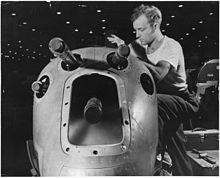History: P-38L s/n 44-53186 was manufactured by Lockheed at their Burbank, California facility in 1945. Sold Surplus in 1946 for $1,250 it was used for aerial mapping until 1967 when it went on display at Harrah Automobile Collection where it remained on display unitl 1982. This P-38 went through several owners before being purchased by Warbirds Of Great Britain. In 1989 it was flown from California to the United Kingdom in an epic transatlantic crossing. Shortly thereafter it was purchased by its current owner and flew back across the Atlantic to Arizona.
It was then sent to Darrell Skurich / Vintage Aircraft Ltd. in Fort Collins, Colorado where it underwent a 100 point restoration. 44-53186 is considered to be the finest P-38 restoration to date.
Since 2003 this P-38L has been on display at the Evergreen Air & Space Museum in McMinnville, Oregon.
Lockheed designed the P-38 in response to a February 1937 specification from the United States Army Air Corps. Circular Proposal X-608 was a set of aircraft performance goals authored by First Lieutenant Benjamin S. Kelsey (later Brigadier General) and First Lieutenant Gordon P. Saville (later General) for a twin-engine, high-altitude “interceptor” having “the tactical mission of interception and attack of hostile aircraft at high altitude.”
Kelsey recalled in 1977 that he and Saville drew up the specification using the word interceptor as a way to bypass the inflexible Army Air Corps requirement for pursuit aircraft to carry no more than 500 lb (227 kg) of armament including ammunition, as well as the restriction of single-seat aircraft to one engine. Kelsey was looking for a minimum of 1,000 lb (454 kg) of armament.
Kelsey and Saville aimed to get a more capable fighter, better at dog-fighting and at high-altitude combat. Specifications called for a maximum airspeed of at least 360 mph (580 km/h) at altitude, and a climb to 20,000 ft (6,100 m) within six minutes, the toughest set of specifications USAAC had ever presented. The unbuilt Vultee XP1015 was designed to the same requirement, but was not advanced enough to merit further investigation.
A similar single-engine proposal was issued at the same time, Circular Proposal X-609, in response to which the Bell P-39 Airacobra was designed. Both proposals required liquid-cooled Allison V-1710 engines with turbo-superchargers and gave extra points for tricycle landing gear.
The Lockheed design team, under the direction of Hall Hibbard and Clarence “Kelly” Johnson, considered a range of twin-engine configurations, including both engines in a central fuselage with push–pull propellers.
The eventual configuration was rare in terms of contemporary fighter aircraft design, with only the preceding Fokker G.1, the contemporary Focke-Wulf Fw 189 Luftwaffe reconnaissance aircraft, and the later Northrop P-61 Black Widow night fighter having a similar planform.
The Lockheed team chose twin booms to accommodate the tail assembly, engines, and turbo-superchargers, with a central nacelle for the pilot and armament. The XP-38 gondola mockup was designed to mount two .50-caliber (12.7 mm) M2 Browning machine guns, with 200 rpg, two .30-caliber (7.62 mm) Brownings, with 500 rpg, and a T1 Army Ordnance 23 mm (.90 in) autocannon with a rotary magazine as a substitute for the non-existent 25 mm Hotchkiss aircraft autocannon specified by Kelsey and Saville. In the YP-38s, a larger John Browning-designed, Colt-made M9 37 mm (1.46 in) autocannon with 15 rounds replaced the T1.
The 15 rounds were in three 5-round clips, an unsatisfactory arrangement according to Kelsey, and the M9 did not perform reliably in flight. Further armament experiments from March to June 1941 resulted in the P-38E combat configuration of four M2 Browning machine guns, and one Hispano 20 mm (.79 in) autocannon with 150 rounds.
Clustering all the armament in the nose was unlike most other U.S. aircraft, which used wing-mounted guns with trajectories set up to crisscross at one or more points in a convergence zone. Nose-mounted guns did not suffer from having their useful ranges limited by pattern convergence, meaning that good pilots could shoot much farther. A Lightning could reliably hit targets at any range up to 1,000 yd (910 m), whereas the wing guns of other fighters were optimized for a specific range.
The rate of fire was about 650 rounds per minute for the 20×110 mm cannon round (130-gram shell) at a muzzle velocity of about 2,887 ft/s (880 m/s), and for the .50-caliber machine guns (43–48-gram rounds), about 850 rpm at 2,756 ft/s (840 m/s) velocity. Combined rate of fire was over 4,000 rpm with roughly every sixth projectile a 20 mm shell. The duration of sustained firing for the 20 mm cannon and .50-caliber machine guns was approximately 14 seconds and 35 seconds, respectively.



